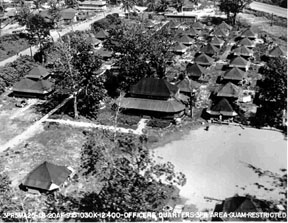“Then the Whiskey Started to Come in Handy”
|
||||||||
| Then the whiskey really started to come in handy. Then we were between the docks and the Corps of Engineers lumber yard, so trucks had to pass us leaving. Every time we’d start running low on lumber, we had somebody wave a bottle of booze at a lumber truck, and we’d have what we needed the next day. For our flight commanders, for a case of booze, we got five Frigidairs to put into our tents. And we had gadgets we could use for making soda water ... so it was quite a setup. The Seabees (construction battalions), and the Navy seemed to control all the goodies, but we swapped our booze for the good things of life, if you will. Quid pro quo. [laughter] |
||||||||
 |
||||||||
|
a tent city in two weeks |
||||||||
| For every flight, there were four or five days of crew rest in between. The men needed places to relax, so we put up a couple of clubs. We built our enlisted club before we built the offerer’s club — wes thought it just made good sense. There was a beautiful bay, where we could swim within the reefs, with lots of sand beaches and coconut trees. There weren’t any gals, but it was still something to do. We would write letters home, go to movies — had lots of movies — and the USO brought in troupes with some famous entertainers.
By now our unit had completely changed its role, from a strategic role in the United States to true reconnaissance, a tactical role. And the crews had gotten bigger. When we started in South America in 1942, flying twin-engined Beechcraft F-2s, we’d take a crew chief, photographer, and the pilot — just three of us. When we got into B-25s, we had a five-man crew. In the B-29, we had mostly eleven-man crews: we had four gunners, including a central fire control gunner, two pilots, a radar navigator, a flight engineer, a radio operator, and a photographer. My first mission out of Saipan was flown to divert attention from our bombers. We arrived thirty minutes ahead of the bomber force southeast of Tokyo. At thirty-two thousand feet, we dropped chaff to confuse the enemy radar. Drawn to our chaff, the Japanese planes came up, and we could see they were all single-engined fighters that were stalling out at around thirty to thirty-one thousand feet. Japanese flack could reach us, but they didn’t have many planes that could go to thirty-three thousand feet, and we were just a couple of thousand feet above them. Our diversion was effective, and the bomber force didn’t have any fighter opposition till they were practically to the target. Instead, we had the fighters on our tails for about a hundred miles. We took a lot of hits on a mission where I wound up with a twenty-millimeter incendiary round in one gas tank. The airplane that did it was one that could stay with us at any altitude, a twin-engined fighter. He picked us up before we ever got to Osaka, and he closed in on us. Our gunners fired back, and he backed off. We went on with our mission to Nagoya and Tokyo, and were coasting out southeast of Tokyo when he made a second pass at us. We had pulled the power back considerably, because once we were off the coast, unless we had fighters in sight, we had to conserve fuel. All of a sudden I heard guns firing. Now, sometimes when we finished a mission we’d cook off a round or two from our guns, but the CFC gunner called and said, “Captain, it’s not a cook-off. Some gook is making a second pass at us.” [laughter] He snuck up under us. He finally gave up, but not before he had hit us many times — fortunately he hadn’t damaged much except the skin. He hit one gas tank with an incendiaqry round that should have blown up, but didn’t. Otherwise, we would have been history [laughter]. After we landed, we found forty to fifty holes in the airplane. My role changed: I went from being a flight commander and pilot to the one planning the operations. My job was concentrated on the mission, period. One of the things that was most important at the altitudes we were flying was the jet stream. You would have a hundred to hundred-and-fifty mile an hour wind, almost west to east, constant, so there was a big difference between coming in from the west and coming in from the east. We’d plan our mission to start out heading for Kyushu, then climb to high altitude on a northeast heading, and then fly roughly west to east to the target. When you had to, you turned, and then came out southeast and gradually let down, which gave you many miles over Japan. If you had flown the mission from east to west, you would have had a very small portion of those miles over Japan. This way we had the opportunity to get three or four times as many targets photographed. End of Page 3 — Go to Page 4 Go To Story Introduction — U of Nevada Reno Page Home - Contact Us - Cold War Hist. - 91st SRS Hist. - Stardust 40 Mission Story - |
||||||||